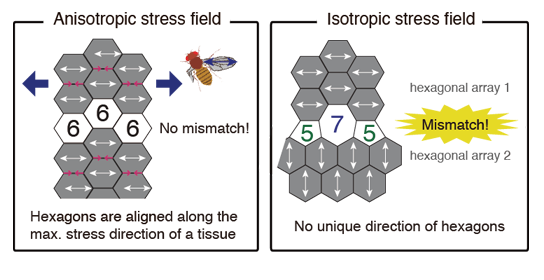Hexagonal cell packing
Anisotropic tissue stress promotes hexagonal cell packing
Many epithelial tissues pack cells into a honeycomb pattern to support their structural and functional integrity. Developmental changes in cell packing geometry have been shown to be regulated by both mechanical and biochemical interactions between cells; however, it is largely unknown how molecular and cellular dynamics and tissue mechanics are orchestrated to realize the correct and robust development of hexagonal cell packing. Here, by combining mechanical and genetic perturbations along with live imaging and Bayesian force inference, we investigate how mechanical forces regulate cellular dynamics to attain a hexagonal cell configuration in the Drosophila pupal wing. We show that tissue stress is oriented towards the proximal-distal axis by extrinsic forces acting on the wing. Cells respond to tissue stretching and orient cell contact surfaces with the stretching direction of the tissue, thereby stabilizing the balance between the intrinsic cell junction tension and the extrinsic force at the cell-population level. Consequently, under topological constraints of the two-dimensional epithelial sheet, mismatches in the orientation of hexagonal arrays are suppressed, allowing more rapid relaxation to the hexagonal cell pattern. Thus, our results identify the mechanism through which the mechanical anisotropy in a tissue promotes ordering in cell packing geometry.References
The mechanical anisotropy in a tissue promotes ordering in hexagonal cell packing.
Development 140: 4091-4101 (2013) [Journal] [In this issue]

